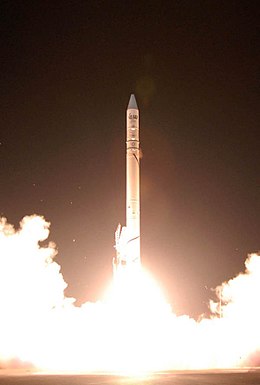Ofeq
 | |
| Manufacturer | Israel Aerospace Industries |
|---|---|
| Country of origin | Israel |
| Operator | Israeli Ministry of Defence / Tsahal |
| Applications | Reconnaissance |
| Specifications | |
| Regime | Low Earth orbit |
| Production | |
| Status | Active |
| Built | 11 |
| Launched | 11 |
| Maiden launch | 19 September 1988 (Ofeq-1) |
| Last launch | 6 July 2020 (Ofeq-16) |
Ofeq, also spelled Offek or Ofek (Hebrew: אופק, lit. Horizon) is the designation of a series of Israeli reconnaissance satellites first launched in 1988. Most Ofeq satellites have been carried on top of Shavit 2 launch vehicles from Palmachim Airbase in Israel, on the Mediterranean coast. The low Earth orbit satellites complete one Earth orbit every 90 minutes. The satellite launches made Israel the eighth nation to gain an indigenous launch capability. Both the satellites and the launchers were designed and manufactured by Israel Aerospace Industries (IAI) with Elbit Systems' El-Op division supplying the optical payload.
Description[]
While exact technical details and capabilities are classified, it is assumed that the Ofeq satellites have an effective operational lifespan of 1–3 years and ultraviolet and visible imaging sensors (except Ofeq-8 and -10 which utilize synthetic-aperture radar (SAR) for all-weather and nighttime reconnaissance). Some reports place the imaging resolution at 80 cm for Ofeq-5.[citation needed] Most non-Israeli satellites are launched eastward to gain a boost from the Earth's rotational speed. However, Ofeq satellites are launched westward (in retrograde orbits) over the Mediterranean to avoid flying over, and dropping spent rocket stages over, populated land areas. Other Israeli satellites (such as the AMOS series) are launched from locations in other countries.[1] Ofeq's east-to-west orbit of 143.0° orbital inclination is phased to give good daylight coverage of the Middle East.[2] Ofeq makes a half-dozen or so daylight passes per day over Israel and the surrounding countries, whereas American and Russian spysats only get one or two passes per day from their higher inclination orbits.
Launch history[]
- Ofeq-1, was launched on 19 September 1988, possessed a weight of 155 kg and circled the Earth on an orbit with a perigee of 249 km and an apogee of 1149 km on a course bent around 142.9°. It accomplished mainly solar cells and radio transmission tests.
- Ofeq-2, was launched on 23 April 1990, on a course with a perigee of 149 km and an apogee of 251 km, bent around 143.2°. It also accomplished communication tests.
- Ofeq-3, the launch of Ofeq-3 was initially postponed from 15 September 1994 to 5 April 1995,[3] was launched on 5 April 1995, was the first operational Israeli satellite with reconnaissance (photography) capabilities. It weighed 225 kg and had a perigee of 369 km and was launched on a new version of Shavit 2.[citation needed]
- Ofeq-4, was launched on 22 January 1998, did not achieve Earth orbit due to a launcher failure and was lost.
- Ofeq-5, was launched on 28 May 2002. The 300 kg Ofeq-5 orbited the Earth on a course with a perigee of 262 km and an apogee of 774 km, bent around 143.5°. During the course of its mission, its perigee was raised to 369 km and its apogee was lowered to 771 kilometers, in an attempt to prolong the satellite's lifespan. Some observers believe that the 300 kg weight of the satellite, combined with the additional propulsive requirements of the retrograde orbit, constitute a de facto demonstration of the Shavit's Intercontinental ballistic missile (ICBM) potential.[citation needed]
- Ofeq-6, was launched on 6 September 2004, encountered another launcher failure, failed to achieve low Earth orbit and crashed to the sea. The launcher failure was due to the third stage of the Shavit 2 launcher.
- TecSAR (Ofeq-8) designation is used for the synthetic-aperture radar satellite launched by an Indian launch vehicle on 21 January 2008.[5]
- Ofeq-9 was successfully launched on 22 June 2010 from Palmachim Air Base using the upgraded Shavit 2 launcher.[5][6]
- Ofeq-10, providing high-resolution synthetic-aperture radar, was successfully launched on 9 April 2014 from Palmachim Airbase using the upgraded Shavit 2 launcher.[2]
- Ofeq-11 was successfully launched on 13 September 2016 from Palmachim Airbase using the upgraded Shavit 2 launcher.[7]
- Ofeq-16 was successfully launched on 6 July 2020 from Palmachim Airbase using the upgraded Shavit 2 launcher.[8]
Israel is not known to have attempted any satellite launches between Ofeq-11 and -16. It is not clear whether the Ofeq-12 through -15 designations have been skipped, or applied to other spacecraft.[9]
References[]
- ^ "AMOS-1 → Intelsat 24". space.skyrocket.de. 18 November 2019. Retrieved 8 May 2021.
- ^ Jump up to: a b Stephen Clark (10 April 2014). "All-weather surveillance satellite put in orbit by Israel". Spaceflight Now. Retrieved 12 April 2014.
- ^ Shavit Federation of American Scientists
- ^ "Israel successfully launches Ofeq-7 satellite". Israel Ministry of Foreign Affairs.
- ^ Jump up to: a b Opall-Rome, Barbara (22 June 2010). "Israel Launches Ofeq-9 Satellite". Defense News. Archived from the original on 7 September 2012. Retrieved 22 June 2010.
- ^ "Israel launches spy satellite". ynetnews.com. 23 June 2010. Retrieved 6 July 2020.
- ^ "Israel Launches New Spy Satellite, Ofeq-11". Haaretz.
- ^ Anna Ahronheim (6 July 2020). "Israel successfully launches Ofek 16 spy satellite into space". The Jerusalem Post. Retrieved 6 July 2020.
- ^ "Space Launch Report: Shavit". Space Launch Report. Archived from the original on 21 December 2019. Retrieved 10 January 2020.
External links[]
- Reconnaissance satellites of Israel
- Earth observation satellites of Israel
- IAI satellites
- First artificial satellite of a country
- Military equipment introduced in the 1980s